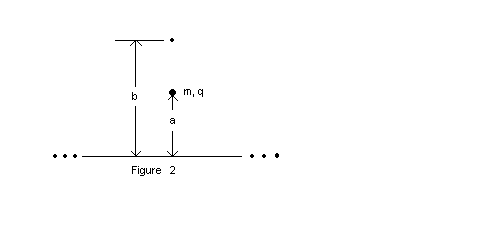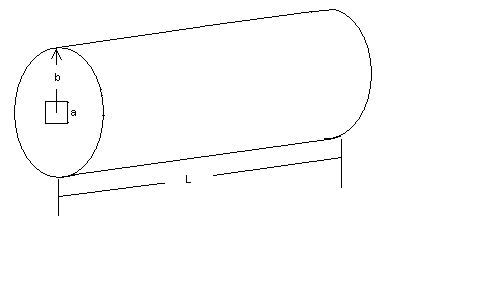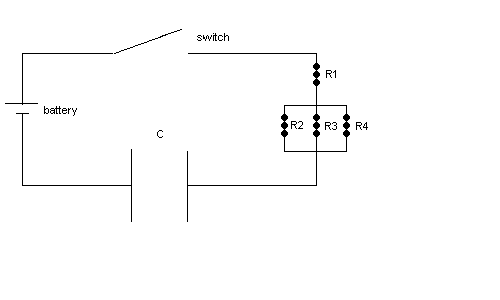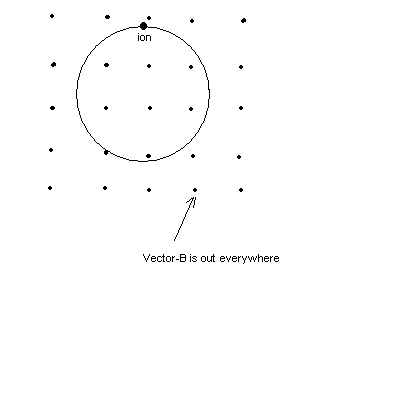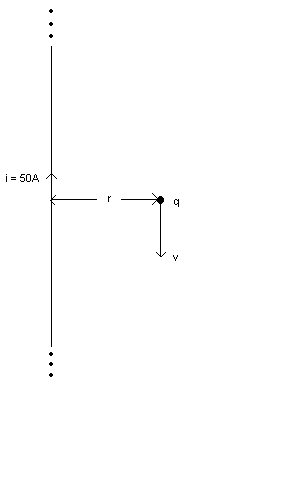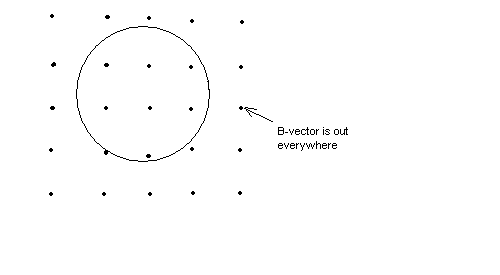| 1. ( 12 points) EXTRA CREDIT Consider
a uniform line of charge of charge per unit density (a)( 7 points) What is the change in electric potential between points at distances a and b from the wire, as shown. The distances are a = 4.0 cm and b = 8.0 cm. (b) ( 5 points) Now focus your attention on Figure 2 below. Suppose a positive point particle of mass m = 1.0x10-30 kg and charge q = 2.0x10-19 C is released from rest at point a. What is the speed of the particle when it arrives at point b?
|
||||||||||
| Solution: (a)  (b) Ki + U i = Kf + Uf 0 + qVi = Kf + qVf 0 + (q)Vi - (q)Vf = Kf(q)(Vi - Vf)= KfSolve for v |
||||||||||
| 2. (20 points) At
200C, a heating element can deliver 500-Watts of power P. The heating
element is a resistor in the shape of a hollow cylinder of length L and
radius b = 2.0 mm. The hollow cavity has a square cross-section of side a
= 1.0 mm. The element is made of Nichrome and thus has a resistivity (a) (12 points) What is the length of the wire?
|
||||||||||
| Solution: (a) See the solution to real test 3. , problem 3 to find the length. Use V2/R = 500 W and solve for the length. (b) Find the new R = R0[1 + 0.4x10-3(1200 - 20)]. Then find the new P = V2/R. Note: R0 is found in part (a). |
||||||||||
| 3. ( 37 points) The
switch is closed at t = 0. The symbol C represents a parallel plate capacitor with plate
area A =1.0 cm2 and a distance between the plates d = 2.0 cm. The battery
voltage is Note:
|
||||||||||
Solution:
|
||||||||||
| 4. (23 points) A singly charged positive ion of charge q = 1.0x10-19 C and mass m = 1.00x10-26 kg is accelerated through a potential difference of V =1000 Volts. The ion then enters a region perpendicular to a magnetic field that has magnitude B = 1.000 T. As indicated below, in this region the magnetic field vector points outward, perpendicular to the plane of the page. The circular orbit of the particle is parallel to the plane of the page. Now focus your attention on the instantaneous position of the ion when it is at the top of the circle.
|
||||||||||
| Solution: (a) Down, toward the center of the circle (b) To the right, tangent to circle. (c) Find v = speed from qV = ½mv2. Note that V = 1000 Volts. The find r = mv/qB |
||||||||||
| 5. ( 20 points) A long wire has a current 50.0 A as shown in the diagram below. At a distance of r = 5.0 cm from the wire, a particle of positive charge with q = 1.0 X10-19 C moves parallel to the wire and in a direction opposite the current. The speed of the particle is v = 1.0x107 m/s.
|
||||||||||
| Solution: (a) Vector-B is in at the location of q. The force points right. (b) F = qvB where, |
||||||||||
| 6. (24 points) A circular loop of wire with radius r = 1.0 m is placed in a region where a uniform magnetic field is perpendicular to the plane of the loop. The magnetic field vector points out. The magnitude of the magnetic field is allowed to vary in time according to the equation:
where t is in seconds. Suppose the loop has a resistance R = 2.0 ohms. (a) ( 10 points) Find the direction of the current i in the loop, either clockwise or counterclockwise, for t > 0. Please indicate this direction by drawing an arrow at the wire. (b) (10 points) What is the magnitude of the current i at t = 2.0 seconds? (c) (2 points) What is the direction of the magnetic moment caused by i
for t >0 ?
|

